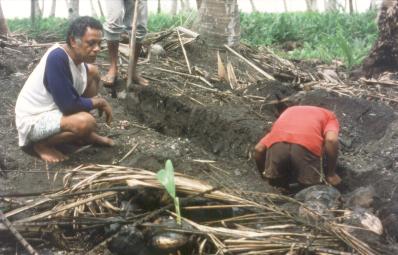|
© University
of Guam. All rights reserved.
Rosalind L. Hunter-Anderson Abstract- Ethnographic and archaeological field work was conducted in 1992 at Tobi, Merir, Pulo Anna, Sonsorol, and Fana. At Tobi, documentation included profiling a wave-cut exposure of a ritual area mound near the landing on the western side of the island and retrieving a soil sample from the base of the mound for radiocarbon dating; locating and describing seventeen earth-oven refuse mounds and excavating a shovel trench into one of them, from which a charcoal sample was retrieved for radiocarbon dating; photographing artifacts observed on the ground surface and in private collections; recording information on traditional resource use at Tobi and nearby Helen Reef; and interviewing older Tobians living in Koror regarding traditional practices. A paleosediment core was taken at an inland taro patch. At Merir, the surface features on the large residential mound near the landing on the west side of the island were sketched in plan and information recorded about the mound's former uses; a shovel trench was excavated into the south flank of the mound, and a paleosediment core was taken at a small taro patch inland of the mound. Artifacts from the surface at the beach were photographed. At Pulo Anna, a shovel trench was excavated into a residential mound and charcoal samples collected for radiocarbon dating and a paleosediment core was taken at the margin of the large inland salt water pond. At Sonsorol, a chiefly meeting house site was mapped and probed; charcoal from the probe was collected for radiocarbon dating; Japanese World War II defensive features were observed and photographed; and historical information about Sonsorol and Fana was obtained. At Fana, several shovel probes were excavated in a midden area at the southern end of the island; soil from the base of one shovel probe was retrieved for radiocarbon dating; a Palauan pottery sherd was found at the base of this trench. Information obtained in the field was compared with and interpreted in light of German and Japanese ethnographic reports from the early part of the 20th century. Our radiocarbon dating results indicate that the Southwest Islands cultures were established at least three hundred years ago and possibly as early as one thousand years before the present; more excavations are needed to establish the occupational sequence at each island. A better understanding of coastal geomorphological processes and their relation to weather and currents in the Southwest Islands is also needed. Considering aged individuals' observations along with historical records, geomorphological, and archaeological data, can result in plausible reconstructions of the islands' past environmental states. This information is crucial to sound planning for the management of the natural and cultural resources of these small islands. Micronesica 33(1/2): pp. 11-44, 2000. |
Fig. 7. Digging the trench at a bonum, Tobi.
![]()
